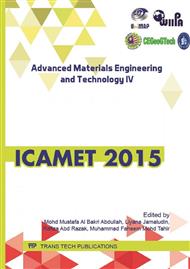p.421
p.426
p.431
p.439
p.447
p.452
p.459
p.465
p.469
Preparation and Characterization of Chitosan/Alginate Polyelectrolyte Complex Prepared by Using Calcium Tripolyphosphate Ionic Gelator
Abstract:
The formation of polyelectrolyte complexes (PECs) between chitosan and alginate has been widely investigated for many pharmaceutical and biomedical uses. Ionotropic gelation resulted from the crosslinking of polyelectrolytes (PEs) in the presence of ionic crosslinkers to form hydrogels. The most widely used ionic crosslinker for chitosan is sodium tripolyphosphate (NaTPP); and Ca2+ ions for alginates. The use of these cross-linkers to prepare PECs of chitosan and alginates resulted in hydrogels of similar moieties: chitosan-chitosan and alginate-alginate rather than the sought for hybrid chitosan-alginate PECs. Calcium tripolyphosphate (CaTPP) is a single molecule ionic gelator of chitosan and alginate that have the capability of producing the true hybrid compound of chitosan/alginate polyelectrolyte complex. This paper reported the synthesis of calcium tripolyphosphate and the preparation of a hybrid chitosan/alginate PECs using this newly identified ionic gelator. The newly-synthesized ionic gelator was characterized using ICP-OES; the PECs thereof prepared were characterized using TGA and SEM. The degradation temperature of the prepared PECs is higher than the degradation temperatures of the individual chitosan and alginates. SEM image of the prepared PECs showed rougher surfaces compared to the images of the individual chitosan and alginate compound. Both TGA and SEM revealed the possibility of the newly prepared material to be of the PECs sought for.
Info:
Periodical:
Pages:
447-451
Citation:
Online since:
May 2016
Keywords:
Price:
Сopyright:
© 2016 Trans Tech Publications Ltd. All Rights Reserved
Share:
Citation:


